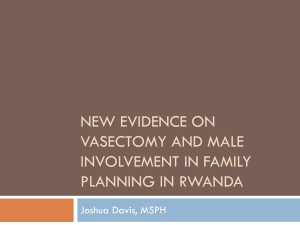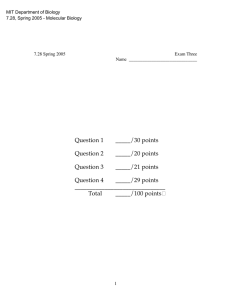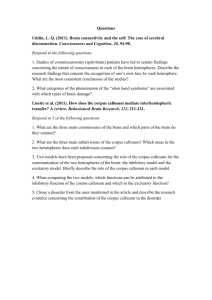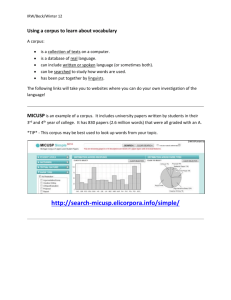Old LibSVM support vector machine testing
advertisement
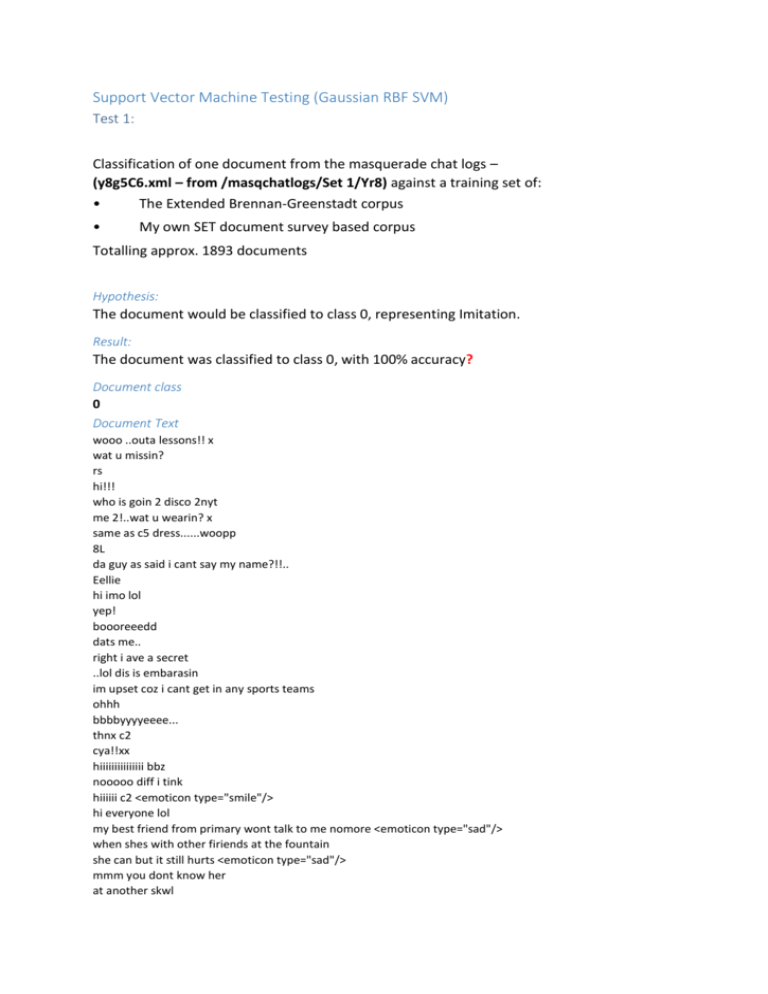
Support Vector Machine Testing (Gaussian RBF SVM)
Test 1:
Classification of one document from the masquerade chat logs –
(y8g5C6.xml – from /masqchatlogs/Set 1/Yr8) against a training set of:
•
The Extended Brennan-Greenstadt corpus
•
My own SET document survey based corpus
Totalling approx. 1893 documents
Hypothesis:
The document would be classified to class 0, representing Imitation.
Result:
The document was classified to class 0, with 100% accuracy?
Document class
0
Document Text
wooo ..outa lessons!! x
wat u missin?
rs
hi!!!
who is goin 2 disco 2nyt
me 2!..wat u wearin? x
same as c5 dress......woopp
8L
da guy as said i cant say my name?!!..
Eellie
hi imo lol
yep!
boooreeedd
dats me..
right i ave a secret
..lol dis is embarasin
im upset coz i cant get in any sports teams
ohhh
bbbbyyyyeeee...
thnx c2
cya!!xx
hiiiiiiiiiiiiiii bbz
nooooo diff i tink
hiiiiii c2 <emoticon type="smile"/>
hi everyone lol
my best friend from primary wont talk to me nomore <emoticon type="sad"/>
when shes with other firiends at the fountain
she can but it still hurts <emoticon type="sad"/>
mmm you dont know her
at another skwl
yeah i have friends!!!!!!
hmmm we'll c <emoticon type="smile"/>
yeaah mite tell her i'm not bothered
naaaaah its coooool7
wuu2 dis weekend?
yeaaaah will do
mmm me too! gt 2 do hmwrk + then cinemaaa woooooo
ny1 goin 2 da disco??!!!
wooooooooo DISCOOOOOOOOO
DISCODISCODISCO
just a dress <emoticon type="smile"/>
yeaaaah THANKS GUYS!!!
dis is boriiiiiiiiiinnnnnn, who r u?
xxx
i'm barney the dinosauuuuurrrr
no rli, who r u?
anna
xxx
yooooooooooooo guys
me tooooooooo
want SOME PIZZZAAAAAA
LOL cafe regent
mmmm love bruno marssssss!!
grenade is sooooo goooooood <emoticon type="smile"/> xx
he's sooooo fitttt!!
yeaaaaahh on waterloo rd he's sooooo goood!
xxx
byeeee c1 xxxxx
think i mite go 22222 byeeeee guys! xxxxxxxxx
Output:
Expected Class(es): 0 Vector(s): {0: 0.8333333333333334, 1: 0.3448275862068965, 2: 1353, 3: 7, 4: 19, 5:
169}
Accuracy = 100% (1/1) (classification)
{'classes': [0.0], 'values': [[0.5357544116729798, 0.46424558832702023]], 'accuracy': (100.0, 0.0, nan)}
Test 2:
Result of a k=5 cross-validation of the following training set:
The Extended Brennan-Greenstadt corpus
o Imitation – Class 0
My own SET document survey based corpus
o Imitation – Class 0
o Obfuscation – Class 1
Totalling approx. 1893 documents
Chosen features
Result:
optimization finished, #iter = 1484
nu = 0.853463
obj = -951.705431, rho = -0.225807
nSV = 1366, nBSV = 948
Total nSV = 1366
.*
optimization finished, #iter = 1524
nu = 0.846096
obj = -939.677400, rho = -0.208196
nSV = 1364, nBSV = 931
Total nSV = 1364
.*
optimization finished, #iter = 1484
nu = 0.831397
obj = -925.413151, rho = -0.208835
nSV = 1330, nBSV = 920
Total nSV = 1330
.*
optimization finished, #iter = 1471
nu = 0.844640
obj = -938.174740, rho = -0.217151
nSV = 1356, nBSV = 941
Total nSV = 1356
.*
optimization finished, #iter = 1561
nu = 0.842478
obj = -940.209623, rho = -0.221545
nSV = 1368, nBSV = 938
Total nSV = 1368
Cross Validation Accuracy = 51.2031%
Conclusion
Since the average accuracy of classification was only slightly above random chance, my model wasn’t
worth using at this time. This was probably due to the set of features I had used to distinguish
between the classes of text - obfuscation and imitation. So, I decided to increase the amount of
features included, in the document representation/feature set per document, in order to specialise
my model, to detecting obfuscation and imitation, as it was currently too general.
Test 3:
Result of a k=5 cross-validation of the following training set:
The Extended Brennan-Greenstadt corpus
o Imitation – Class 0
My own SET document survey based corpus
o Imitation – Class 0
o Obfuscation – Class 1
Totalling approx. 1893 documents
Chosen features
Result
*
optimization finished, #iter = 955
nu = 0.925874
obj = -1323.932837, rho = -0.937927
nSV = 1342, nBSV = 1305
Total nSV = 1342
*
optimization finished, #iter = 984
nu = 0.925874
obj = -1323.856633, rho = -0.925445
nSV = 1338, nBSV = 1311
Total nSV = 1338
*
optimization finished, #iter = 959
nu = 0.925122
obj = -1321.810979, rho = -0.885390
nSV = 1336, nBSV = 1303
Total nSV = 1336
*
optimization finished, #iter = 996
nu = 0.925874
obj = -1323.834650, rho = -0.862457
nSV = 1336, nBSV = 1310
Total nSV = 1336
*
optimization finished, #iter = 953
nu = 0.925122
obj = -1321.794238, rho = -0.848871
nSV = 1332, nBSV = 1309
Total nSV = 1332
Cross Validation Accuracy = 53.7213%
Conclusion
Due to normalizing my features, the cross validation accuracy of my classifier, improved by 2.5182%.
This was a good result, but the accuracy needed to be of a much greater level, before it would be
worth using the classifier. After this, I decided to include more data in my classifier’s model:
Masquerade chat logs (Internet messaging)
o Class 0
And a couple of features to get information out of that data:
Proportion of incorrectly spelt words
Punctuation level/count
Implementation of ‘Proportion of incorrectly spelt words’:
This required a way to track spelling errors, and therefore I would need some kind of
dictionary corpus, to compare words to. This is when I found the ‘big.txt’ corpus file, put
together by Peter Norvig. It contains text from Project Gutenberg’s public domain books,
and lists of frequent words from Wikitionary and the British National Corpus [1].
[1] Source: http://norvig.com/spell-correct.html
This corpus seemed to be a great choice, alone, for detecting spelling errors. But, I had
noticed that the SET emails I had previously tested with, contained slang, and grammar
mistakes, which wouldn’t be picked up by the corpus. So, an extra corpus would be
required:
[EXTRA: Birkbeck spelling error corpus, by Roger Mitton.
It contains text from misspellings in children’s tests, short novels, and excerpts of freewriting by students of adult-literacy. The range of time that it spans, goes from the early 20th
century to the 80’s. Source: http://www.ota.ox.ac.uk/headers/0643.xml]
